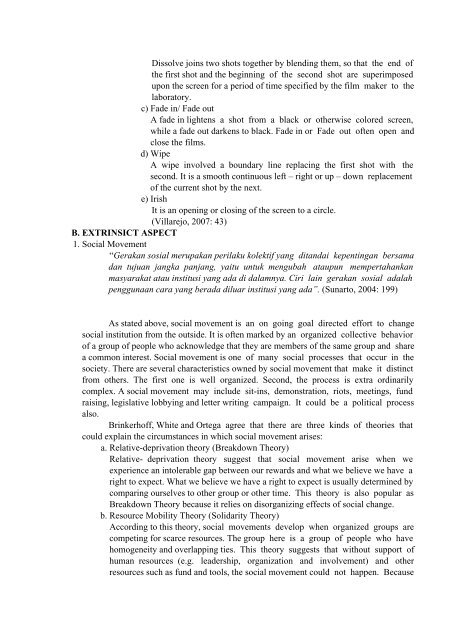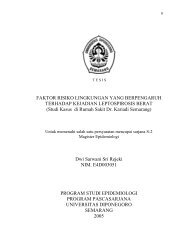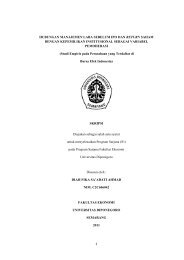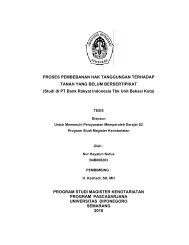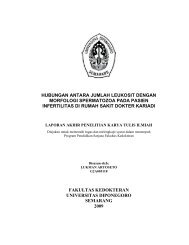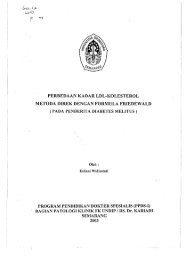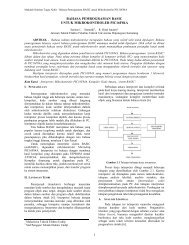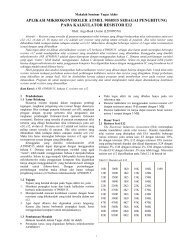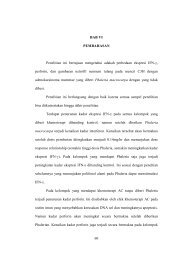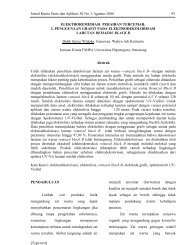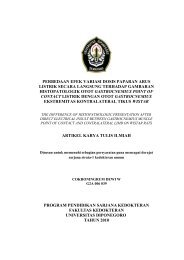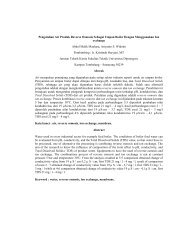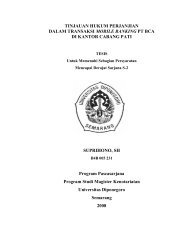the social movement of gay community in gus van sant film entitled ...
the social movement of gay community in gus van sant film entitled ...
the social movement of gay community in gus van sant film entitled ...
You also want an ePaper? Increase the reach of your titles
YUMPU automatically turns print PDFs into web optimized ePapers that Google loves.
Dissolve jo<strong>in</strong>s two shots toge<strong>the</strong>r by blend<strong>in</strong>g <strong>the</strong>m, so that <strong>the</strong> end <strong>of</strong><br />
<strong>the</strong> first shot and <strong>the</strong> beg<strong>in</strong>n<strong>in</strong>g <strong>of</strong> <strong>the</strong> second shot are superimposed<br />
upon <strong>the</strong> screen for a period <strong>of</strong> time specified by <strong>the</strong> <strong>film</strong> maker to <strong>the</strong><br />
laboratory.<br />
c) Fade <strong>in</strong>/ Fade out<br />
A fade <strong>in</strong> lightens a shot from a black or o<strong>the</strong>rwise colored screen,<br />
while a fade out darkens to black. Fade <strong>in</strong> or Fade out <strong>of</strong>ten open and<br />
close <strong>the</strong> <strong>film</strong>s.<br />
d) Wipe<br />
A wipe <strong>in</strong>volved a boundary l<strong>in</strong>e replac<strong>in</strong>g <strong>the</strong> first shot with <strong>the</strong><br />
second. It is a smooth cont<strong>in</strong>uous left – right or up – down replacement<br />
<strong>of</strong> <strong>the</strong> current shot by <strong>the</strong> next.<br />
e) Irish<br />
It is an open<strong>in</strong>g or clos<strong>in</strong>g <strong>of</strong> <strong>the</strong> screen to a circle.<br />
(Villarejo, 2007: 43)<br />
B. EXTRINSICT ASPECT<br />
1. Social Movement<br />
“Gerakan sosial merupakan perilaku kolektif yang ditandai kepent<strong>in</strong>gan bersama<br />
dan tujuan jangka panjang, yaitu untuk mengubah ataupun mempertahankan<br />
masyarakat atau <strong>in</strong>stitusi yang ada di dalamnya. Ciri la<strong>in</strong> gerakan sosial adalah<br />
penggunaan cara yang berada diluar <strong>in</strong>stitusi yang ada”. (Sunarto, 2004: 199)<br />
As stated above, <strong>social</strong> <strong>movement</strong> is an on go<strong>in</strong>g goal directed effort to change<br />
<strong>social</strong> <strong>in</strong>stitution from <strong>the</strong> outside. It is <strong>of</strong>ten marked by an organized collective behavior<br />
<strong>of</strong> a group <strong>of</strong> people who acknowledge that <strong>the</strong>y are members <strong>of</strong> <strong>the</strong> same group and share<br />
a common <strong>in</strong>terest. Social <strong>movement</strong> is one <strong>of</strong> many <strong>social</strong> processes that occur <strong>in</strong> <strong>the</strong><br />
society. There are several characteristics owned by <strong>social</strong> <strong>movement</strong> that make it dist<strong>in</strong>ct<br />
from o<strong>the</strong>rs. The first one is well organized. Second, <strong>the</strong> process is extra ord<strong>in</strong>arily<br />
complex. A <strong>social</strong> <strong>movement</strong> may <strong>in</strong>clude sit-<strong>in</strong>s, demonstration, riots, meet<strong>in</strong>gs, fund<br />
rais<strong>in</strong>g, legislative lobby<strong>in</strong>g and letter writ<strong>in</strong>g campaign. It could be a political process<br />
also.<br />
Br<strong>in</strong>kerh<strong>of</strong>f, White and Ortega agree that <strong>the</strong>re are three k<strong>in</strong>ds <strong>of</strong> <strong>the</strong>ories that<br />
could expla<strong>in</strong> <strong>the</strong> circumstances <strong>in</strong> which <strong>social</strong> <strong>movement</strong> arises:<br />
a. Relative-deprivation <strong>the</strong>ory (Breakdown Theory)<br />
Relative- deprivation <strong>the</strong>ory suggest that <strong>social</strong> <strong>movement</strong> arise when we<br />
experience an <strong>in</strong>tolerable gap between our rewards and what we believe we have a<br />
right to expect. What we believe we have a right to expect is usually determ<strong>in</strong>ed by<br />
compar<strong>in</strong>g ourselves to o<strong>the</strong>r group or o<strong>the</strong>r time. This <strong>the</strong>ory is also popular as<br />
Breakdown Theory because it relies on disorganiz<strong>in</strong>g effects <strong>of</strong> <strong>social</strong> change.<br />
b. Resource Mobility Theory (Solidarity Theory)<br />
Accord<strong>in</strong>g to this <strong>the</strong>ory, <strong>social</strong> <strong>movement</strong>s develop when organized groups are<br />
compet<strong>in</strong>g for scarce resources. The group here is a group <strong>of</strong> people who have<br />
homogeneity and overlapp<strong>in</strong>g ties. This <strong>the</strong>ory suggests that without support <strong>of</strong><br />
human resources (e.g. leadership, organization and <strong>in</strong>volvement) and o<strong>the</strong>r<br />
resources such as fund and tools, <strong>the</strong> <strong>social</strong> <strong>movement</strong> could not happen. Because


